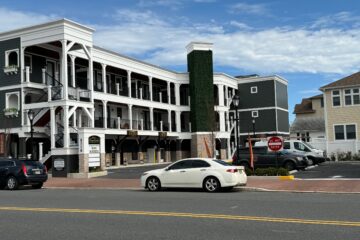MARGATE – The city engineer issued a report Aug. 2 informing the Board of Commissioners and the public about the steps that need to be taken to construct a boardwalk along the beach.
Margate resident Glenn Klotz in April petitioned the administration to extend the boardwalk from Ventnor to the city’s border with Longport along the landward side of the new dune. Officials embraced the idea and agreed to investigate the matter further.
Klotz said a boardwalk would convert a “now useless part of the beach” into a “wonderfully useful public space,” provide better access to the beach for seniors and the disabled, and provide a recreational amenity for walkers, runners and bicycle enthusiasts.
The cost of building a boardwalk with pine decking would be $18.4 million, not including street end pedestrian ramps or lighting, engineers at Remington, Vernick and Walberg estimate.
Telephone calls were made to the NJ Department of Environmental Protection to determine the feasibility of the project, but the city has not received a response, city Engineer Ed Walberg said.
But, in an “off the record” conversation with a high-ranking DEP official, Walberg was told it would be “highly unlikely” that a boardwalk could be built on the beach, his memo states.
Nevertheless, the city would still have to go through a formal permitting process before anyone says no, the official said.
Joe Johnston of RVW provided the steps the city would have to take to determine if the project could move forward, starting with a pre-application conference with DEP officials.
The pre-application conference would identify conflicts, determine regulatory compliance, and provide recommendations for design changes that would minimize the disturbance of environmentally sensitive areas. If the city clears the first hurdle, there is still no guarantee the project would be approved, he stated in his memo.
Walberg said the city would also have to go through a permitting process with the U.S. Army Corps of Engineers, which funded the building of the protective sand dune last summer.
In a second memo to Walberg, Johnston states Coastal Zone Management Rules indicate a boardwalk would not be possible, mostly because it could interfere with the engineered beach berm and dune system.
The rationale for the regulations include: “For engineered beaches to provide storm damage reduction and shore protection for which they were designed, the beach berm design template must be maintained throughout the entire project area,” the memo states.
The documents have been posted on the city’s website, margate-nj.com.
Klotz said what the city received from its engineers is nothing more than “standard operating procedure.”
“The DEP has to say that, but it is mandated to provide public accommodations in public parks,” Klotz said.
Commissioner John Amodeo said he met with Klotz and members of the Boardwalk Committee on Monday to discuss what it would entail to move forward.
“We will go through the process because they gave us the request,” Amodeo said.
They agreed to hold a public meeting with all stakeholders, including the DEP and Army Corps, he said.
“My biggest concern is the cost to taxpayers,” Amodeo said. “Approving a bond would substantially increase taxes. When the time comes, we will go to a referendum, but it’s too premature at this point to say when that will be. We’re still at the first step.”
Although Klotz has garnered substantial support for building the boardwalk, four members of the public spoke against it at the Aug. 2 meeting, mainly because of the cost.
Klotz said the Boardwalk Committee will prepare its own white paper on the feasibility of building the boardwalk.. Concessions may be needed for several “narrow” spots where the dune is about 30 feet from the bulkhead. Those areas are from the Margate Pier to Delavan Avenue, which would come close to three homes; Kenyon to Osborne Avenue, a four-block area that would come close to nine homes; and one home at Rumson Avenue, Klotz said.
Klotz said the $18.4 million figure Walberg quoted is not accurate, and that he was told it would cost between $25 and $30 million to provide all the amenities.
“There are so many variables to decide, such as materials, width, etc. Until we get a clearer picture of the design, we can’t say the exact price,” Klotz said. “And everyone wants to know the cost.”
Once the city has a better idea about permitting and cost, it should be put before the voters.
“Our committee recommends that the public decide the issue after all the facts come out,” Klotz said.
That’s not likely to happen for the November election, but a public question could be on the May 2019 commission election ballot if the commissioners agree to go to referendum, or the committee could get a petition signed by 10 percent of the voting public to get a question on the ballot, Klotz said.
Additionally, non-resident property owners should be surveyed to determine their support, he said.
“If the public wants it, great,” Klotz said. “I won’t be disappointed if they don’t. The people speak, and then we move on.”
Klotz said he is working with the Margate Historical Society to put together an educational program on the history of the old Margate boardwalk with the Boardwalk Committee presenting on the new boardwalk, he said. However, no date or time has been set.
“We’re going to do some public relations and do some talks around town, before we appear before the commission,” Klotz said.
“It’s too early to say for sure there will be a boardwalk,” he said, “but we can agree to continue to investigate it.”


